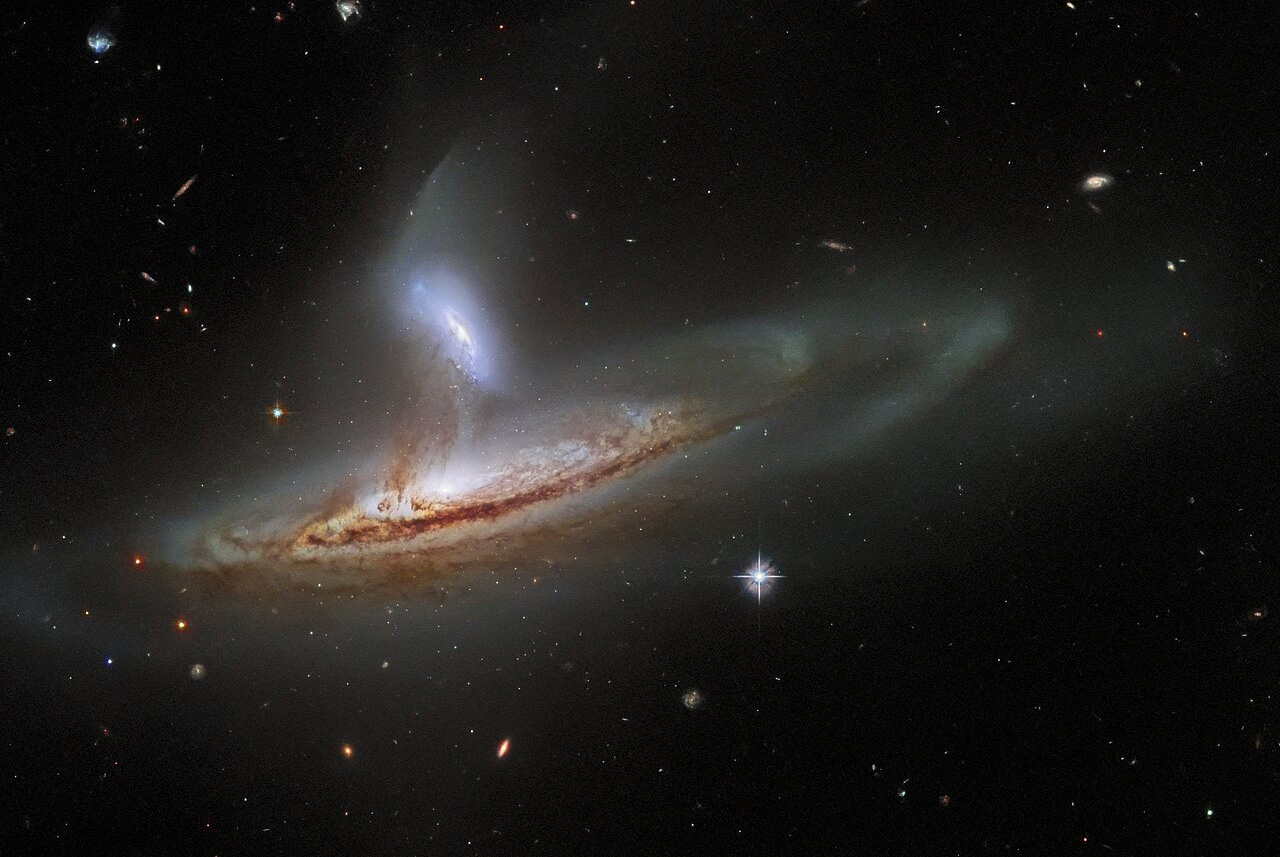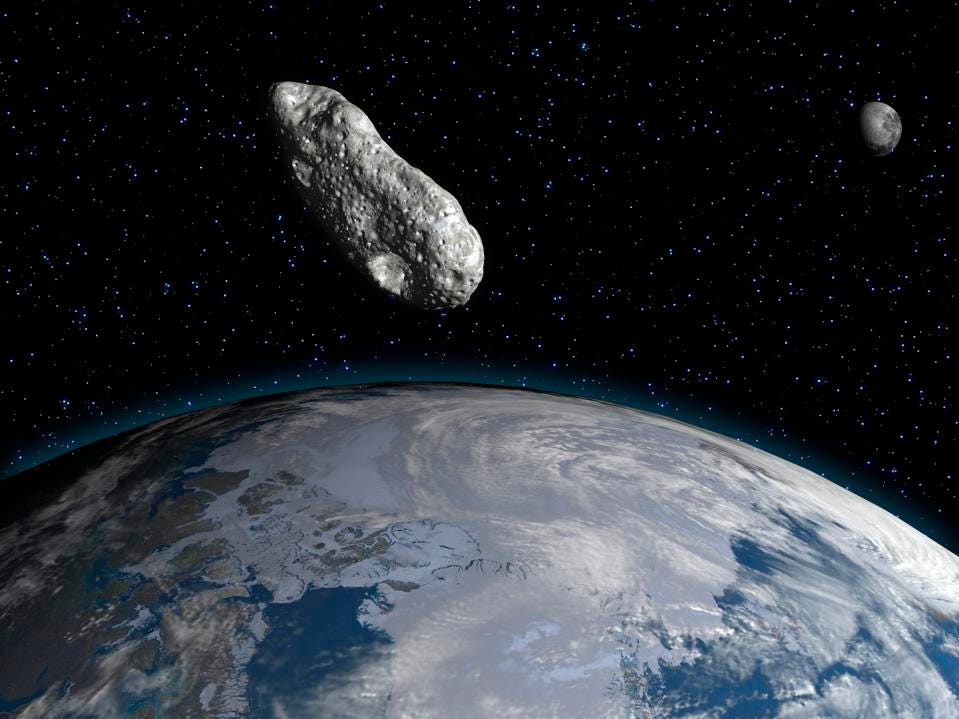Small asteroid 2023 DZ2 came close to Earth at a distance of half the distance between the Earth and the Moon, which was observed with methods of radar astronomy and optical telescopes – including amateur Hungarian astronomers who also imaged it with telescopes.
CCD images taken on February 27, 2023 with the 2.5-meter Isaac Newton Telescope at the Roque de los Muchachos Observatory (La Palma, Canary Islands, Spain) revealed a moving object with an apparent brightness of magnitude 20.3, showing no coma or plume, But it was star-like, so it could be a small asteroid-like object. Subsequently, other observatories and amateur astronomers took pictures and tracked the small orb, so that an increasingly precise trajectory could be determined from the locations collected, and knowledge of its physical properties and composition could be obtained. Observations revealed that it is indeed an asteroid, and thus 2023 DZ2 was given the provisional designation.
The image below shows a remote control shot by Italian astrophysicist and amateur astronomer Gianluca Massi on March 22, 2023 with one of the robotic telescopes (C14) of the Virtual Telescope Project 2.0.
Gianluca Masi has also created animations from his recordings, which are pictured below.
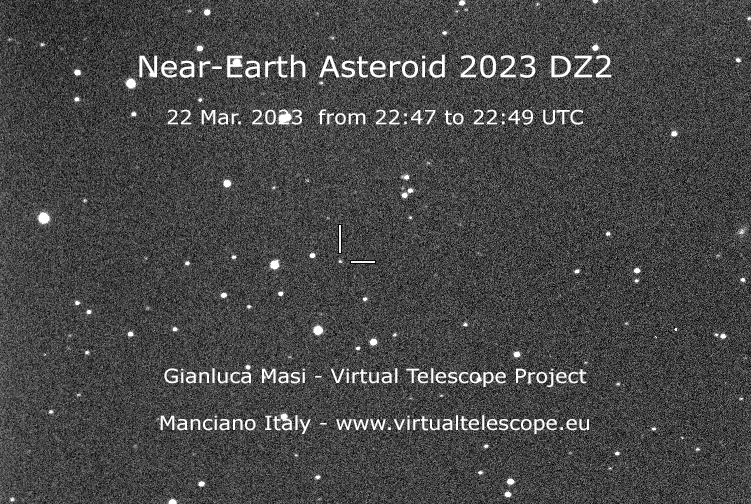
According to NASA JPL orbit data, 2023 DA2 orbited the Sun in an elliptical orbit with a semi-major axis of 2.159 CSE before approaching Earth, passing 0.994 CSE near the Sun and 3.324 CSE on the far side of the Sun from our central star. The orbital eccentricity is 0.534, and the orbital period is 3.173 years. The plane of the orbit forms an angle of only 0.08 degrees with the plane of Earth’s orbit (the ecliptic). Based on its orbit, 2023 DZ3 belongs to the Apollo orbit-type near-Earth asteroids.
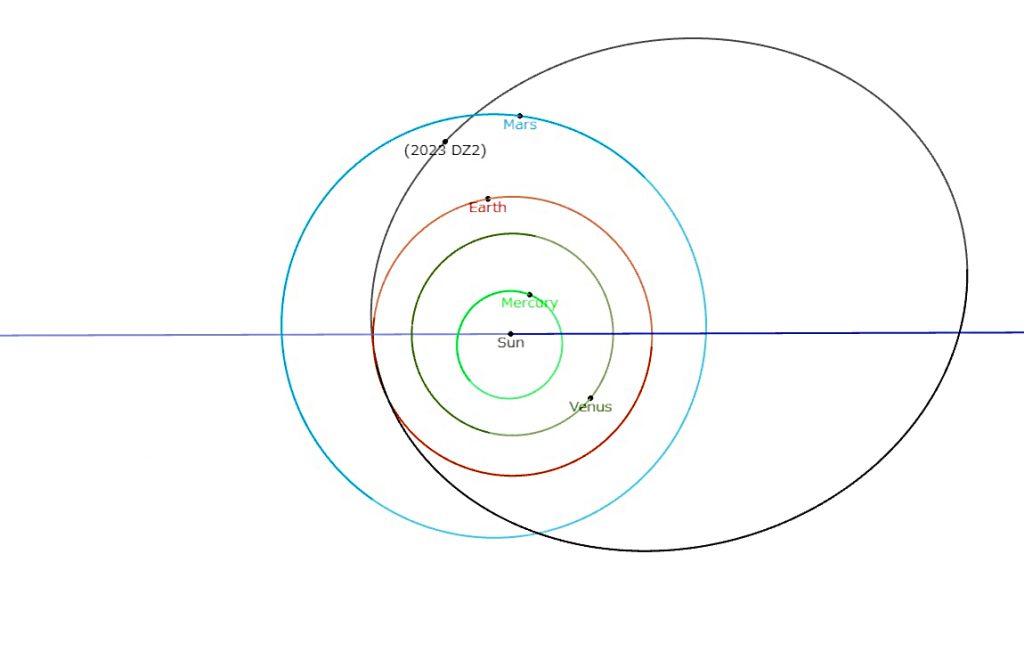
It turns out that 2023 DZ2 will be closest to the Moon on March 25, 2023 at 14:02 UTC at 0.0345 CSE, or about 516 thousand km, and at 0.00117 CSE at 19:51 UTC, that is, it passed from the closest point. It is about 174,000 km from the center of the Earth, which is about 0.45 times the average distance between the Earth and the Moon. . The asteroid shot past Earth at a speed of about 7.8 km/s.
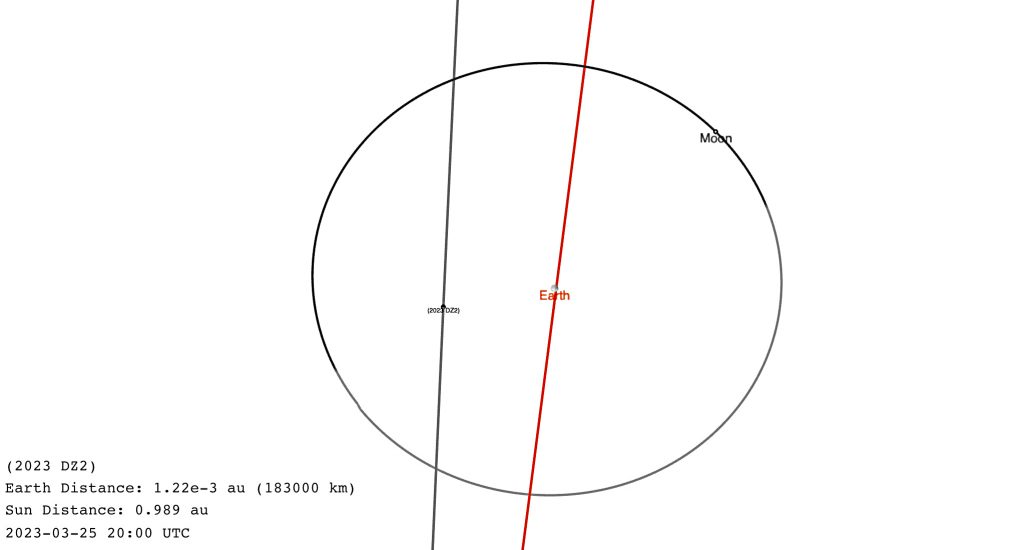
The asteroid’s orbit was expected to change slightly as it passed through the Earth-Moon system. According to the preliminary calculations of the ESA (European Space Agency) Center for Near-Earth Objects, after its approach to the Earth, the point of proximity of the sun to the asteroid’s orbit decreased from 0.994 CSE to 0.991 CSE, the eccentricity decreased from 0.539 to 0.524, and its orbital period shortened from 3.317 years to 3.176 years. . The inclination of the orbit to the plane of the ecliptic increased from 0.08° to 0.15°. 2023 DZ2 continued its trajectory after its current approach to Earth, with a slightly altered trajectory compared to the one it had before the approach. The type of Apollo trajectory has not changed.
The question arises: What are the prospects for the 2023 DZ2 to collide with our planet in the future? This asteroid will again be very close to Earth at 02:01 UTC on April 4, 2026, at about 0.00677 CSE, or 1.012 million km. Based on its current trajectory, calculated from observations covering a period of one month, it can be concluded that this asteroid does not pose a collision risk to our planet, and similarly there will be no collision during its return in 2029.
The approximate size, shape, and composition of 2023 DZ2 can already be estimated from ground-based, infrared and radar astronomical observations. The optical light curve, caused by the elongated and irregular shape of the small celestial body rotating on its axis, showed a maximum minimum amplitude change of about 0.57 degrees and a rotation period of 0.105 hours (6.264 minutes). We don’t yet know the surface reflectivity (albedo). Based on observations from NASA’s 3.2-meter Infrared Telescope (Mauna Kea, Hawaii), 2023 DZ2 is a spectral X asteroid, of either spectral type E or M, i.e. rather E (enstatite chondrite surface) or M (metallic) It is more likely than type P which also belongs to type X, which will have a low albedo.
2023 DZ2 was also observed using radar astronomy instruments with two large antennas of NASA’s Deep Space Network in Goldstone, California, not far from each other, the 70-meter DSS-14 and 34-meter DSS-13 antennas – the interesting thing about the measurements is that They were conducted in binary mode, i.e. by giving DSS-14 and receiving DSS-13 signals. Radar observations show a small, elongated, rapidly rotating asteroid, which is consistent with observations obtained with optical telescopes. Radar sightings were made at Goldstone on March 25 and 27. Unfortunately, Arecibo’s giant radio telescope, which could have been used to obtain more detailed radar images of the nearby asteroid, is no longer operational. The figure below shows one of the recorded radar images.
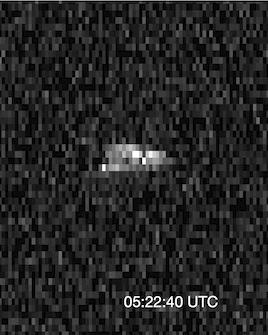
The size of 2023 DZ2 is estimated to be between 40 and 90 meters, which is equivalent to a meteorite or a small asteroid, but such a relatively large meteorite passes between the Earth and the Moon only every 5 to 10 years. The average size of this small asteroid is 50-70 meters. By the way, several meters smaller than 10 are identified every year passing between the Earth and the Moon, and even many of them enter the Earth’s atmosphere and are destroyed there, such as the newest 2023 CX1, which was discovered a few hours before entering our planet’s atmosphere at the top of the Sarniczky Crysztian Beszkisteto.
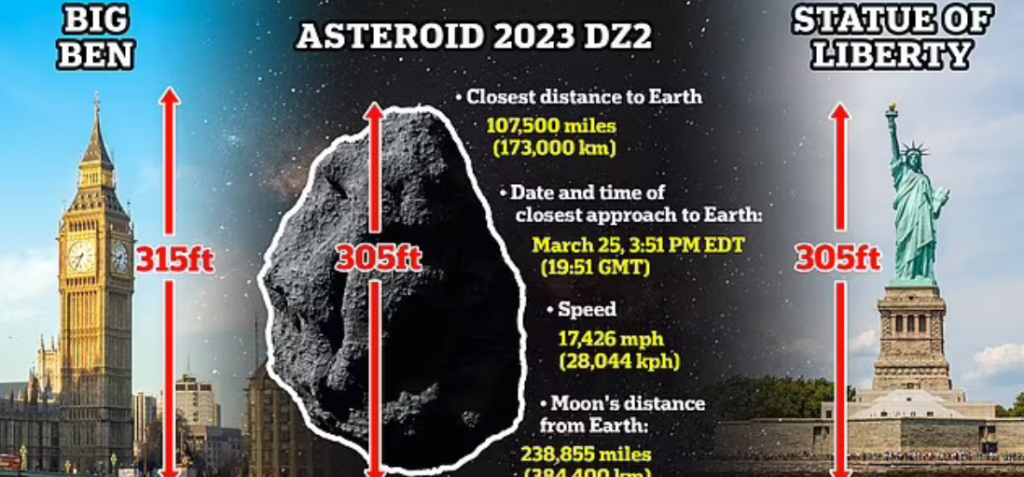
By the way, the small asteroid 2023 DZ2 that has now approached Earth can be seen
In the future it will not pose a risk of crashing into the ground. It is important to note that today we are not aware of any naturally occurring small celestial body that might collide with our planet, but research and follow-up, i.e. observations, must continue unabated.
By the way, the estimated size of 2023 DZ2 at an altitude of 50-70 meters corresponds to the estimated size of the small asteroid that caused the Tungus phenomenon in 1908. It is estimated that if 2023 DZ2 enters the Earth’s atmosphere, the energy equivalent to an explosion of about 4.5 megatons of matter TNT (19 PJ) would have been fired in the form of an airburst (fireball and shock wave). The energy of the Tunguz event is estimated to be between 3 and 30 megatons of TNT equivalent. The Tungus event can also be classified as a “city-destroying” localized cosmic catastrophe with an area of about 50 by 50 km.2 Land clearing in the Siberian taiga. Fortunately, the 2023 DZ2 narrowly missed our planet.
When 2023 DZ2 was close to Earth, its apparent brightness was in the range of 10-11 magnitude, which made it possible to observe it with small telescopes: both visually and photographically.
It is no coincidence that Hungarian amateur astronomers observed and recorded asteroid 2023 DZ2 on the night of its approach to Earth. Antal Kocsis, Laszlo Gobicza and Ksaba Nemeth of the Balaton Star Observatory in Balatonvosvi successfully imaged the asteroid passing near Earth. According to the observation report, after heavy rain, the asteroid, visible among cloud gaps and clouds in a clear or veiled sky, at an altitude of barely 8 degrees, was photographed with a Canon 500D mounted on a 100/900mm ED refractor, ISO 3200, with an exposure of 30 second. A whole series was captured, and now just that single 30-second exposure (the clip-on) is shown in the image below, which clearly shows how much displacement the asteroid made in 30 seconds from west to east. JPL gave a magnitude of 11.7 for brightness, perhaps a little weaker than that.
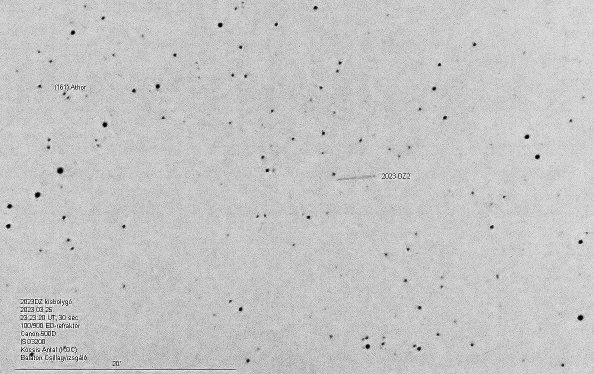
The article is related to the project GINOP-2.3.2-15-2016-00003 “Global Impacts and Risks”.
sources:
comment






















